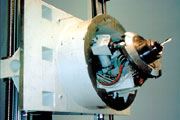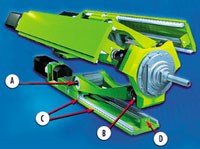A New Twist On Five-Axis Machining
Cincinnati Machine and DS Technologie Gmbh (DST) announced a strategic alliance through which machine tools, service and support from both companies will be offered to the aerospace industry in North and South America through Cincinnati Machine.
Share




In May 2000, Cincinnati Machine and DS Technologie Gmbh (DST) announced a strategic alliance through which machine tools, service and support from both companies will be offered to the aerospace industry in North and South America through Cincinnati Machine.
One of the first examples of this alliance is a new multi-axis machining head developed by DST and now available from Cincinnati Machine. It’s designed to give performance improvements in thin wall machining applications for aluminum aerospace structural components.
Called the Z3 head, it’s a horizontal parallel linked tripod that uses three parallel linear ways and ballscrews attached by linkage to a spindle carrier. The unit is designed to achieve virtually any combination of linear and rotary motion within the head’s working zone.
To visualize how this unit operates, picture three parallel horizontal legs, all attached at one end to a spindle housing. Each of the legs attaches to the housing at 120 degrees around the periphery using a ball joint so the housing can pivot.
The other ends of the legs attach via a joint to a block that travels in the plus and minus Z-axis direction carried on a fixed set of parallel linear guide ways. Under the block is an attached ballnut through which a ballscrew spins.
Each of the three ballscrews is powered by it own servomotor. As each of the three ballscrews spins, its respective block moves the spindle housing.
When all three ballscrews are actuated in unison, the spindle housing moves in a straight, plus or minus, Z-axis direction. Program the ballscrews to move independently, and the carrier, with its spindle, can create A and B axes of motions. Range for these motions is plus or minus 40 degrees about the A or B axes.
The triangulation setup using parallel links gives the spindle high stiffness characteristics in both dynamic and static modes. Because of the reduced mass of the design, axial acceleration and deceleration for the Z3 head is 1G. Rapid feedrates are at 1,968 inches per minute.
According to Cincinnati Machine, since the depth requirement of most aerospace components is no more that 12 inches, the Z3 head’s Z-axis travel has been limited to 26.4 inches. This limited stroke gives the head rigidity to better machine thin wall sections in aluminum aerospace structural components.
The new Z3 head accommodates a motorized spindle with speed ranges of 7,500 to 40,000 available. Spindles up to 100 hp can be accommodated by the Z3 head design. Three different spindle brands are being offered for use in the Z3 to give users a choice of speed and torque combinations for various machining applications.
Initially, Cincinnati Machine will offer the Z3 head on its line of Hypermach horizontal profilers. These machines are specifically designed for high speed milling of aerospace structural components.
Related Content
-
Building Machines and Apprenticeships In-House: 5-Axis Live
Universal machines were the main draw of Grob’s 5-Axis Live — though the company’s apprenticeship and support proved equally impressive.
-
Inverting Turning and Five-Axis Milling at Famar
Automation is only the tip of the iceberg for Famar, which also provides multitasking options for its vertical lathes and horizontal five-axis machine tools.
-
Which Approach to Automation Fits Your CNC Machine Tool?
Choosing the right automation to pair with a CNC machine tool cell means weighing various factors, as this fabrication business has learned well.



























